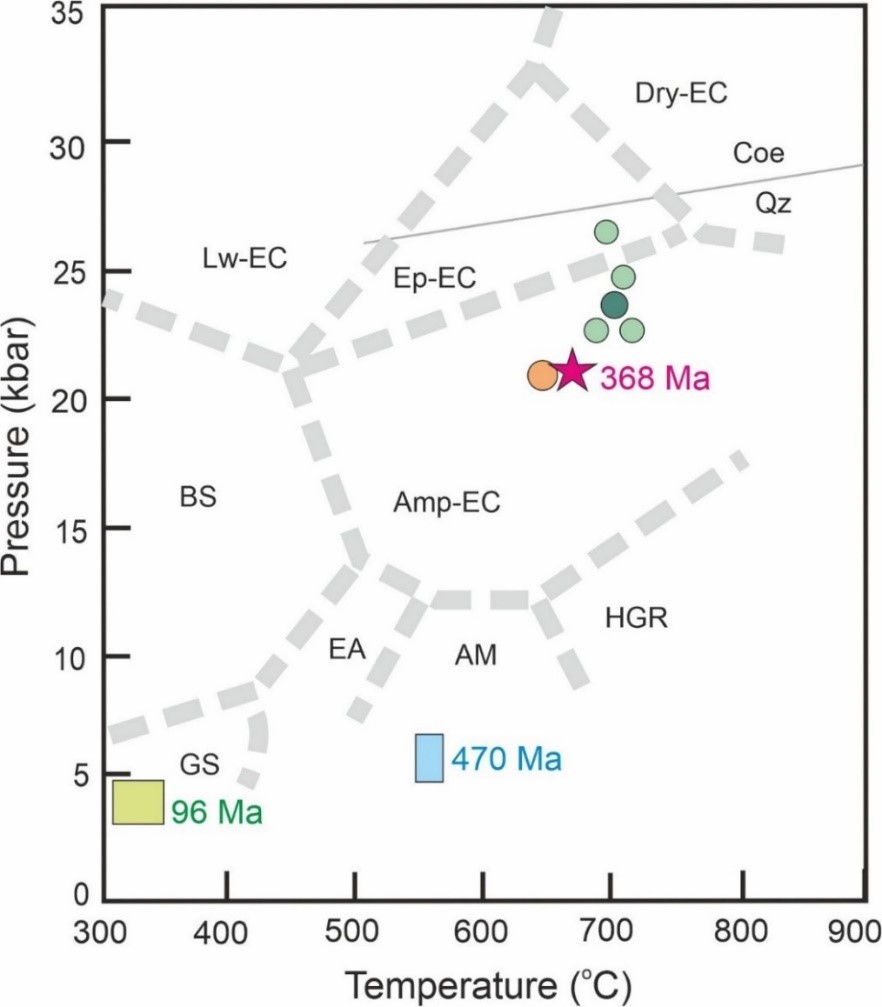Basic research
MYŠĽAN, Pavol – ŠTEVKO, Martin – MIKUŠ, Tomáš – VACULOVIČ, T. Mineralogy and genesis of sapphire in corundum-bearing xenoliths from the Miocene andesites in the Záhradné, Hubošovce and Vechec quarries in the Slanské vrchy Mountains (Slovakia). In Geologica Carpathica, 2024, vol. 75, no. 2, p. 117-131. (2023: 1 – IF, Q4 – JCR, 0.42 – SJR, Q2 – SJR). ISSN 1335-0552.
https://doi.org/10.31577/GeolCarp.2024.06
New occurrences of sapphire crystals have been discovered in corundum-bearing xenoliths within Miocene andesites of the Slanské vrchy Mountains in eastern Slovakia. These crystals occur in micaceous xenoliths made of dark mica, pyroxenes, K-feldspars, plagioclase, hercynite, ilmenite, and magnetite, at Záhradné and Hubošovce quarries. Sapphires are also found in cordieritic xenoliths, which mainly consist of cordierite, plagioclase, sillimanite, hercynite, and ilmenite, discovered at Vechec quarry. The sapphires range from dark blue to light blue and have a vitreous to diamond-like luster, with a pseudohexagonal shape, crystals are up to 2 mm in size and often feature triangular patterns on their faces. Chemical analysis showed that the sapphires are mostly composed of Al2O3 (98.12–99.60 wt.%) with trace amounts of Fe, Ti, Cr, V, Mg, and Ga, and occasionally Na, Ca, K, B, and Li. Sapphires formed from Al-rich metasediments that were incorporated into a magmatic reservoir, causing a high-temperature transformation suitable for corundum crystallization.
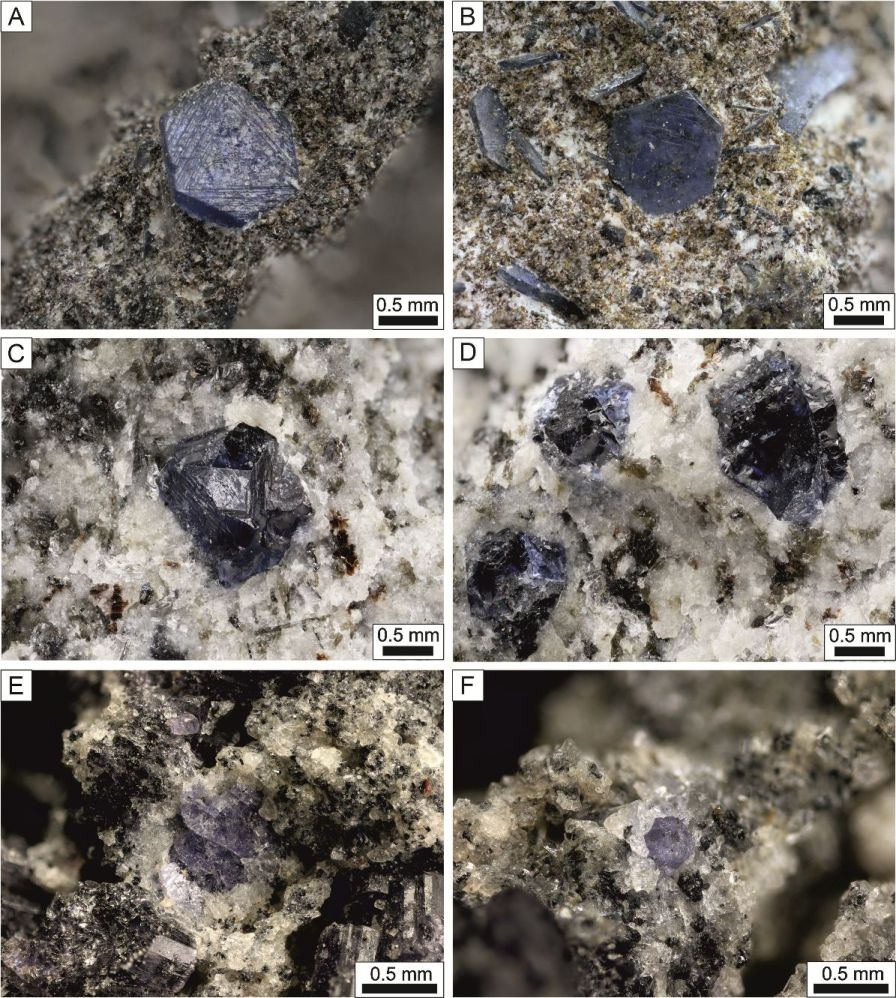
BROSKA, Igor – PETRÍK, Igor – YI, Keewook – MAJKA, Jarosław – BARNES, Christopher – VOJTKO, Rastislav – MADARÁS, Ján – KURYLO, Sergiy – KUBIŠ, Michal. Alpine stacking of two Variscan granite blocks recognised from mineral stabilities, age and structural data (Western Carpathians). In Chemical Geology, 2024, vol. 648, art. no. 121959. (2023: 3.6 – IF, Q1 – JCR, 1.506 – SJR, Q1 – SJR). ISSN 0009-2541.
https://doi.org/10.1016/j.chemgeo.2024.121959
Mineralogical and petrological analysis together with tectonic measurements in Tribeč Mts. led to the discovery that the granite body, which was formed about 355 million years ago during the Variscan orogeny and forms the main geological structure of the Tribeč-Zobor block, actually consists of two parts that have been stacked from the period of Alpine folding, which was about 80 million years ago. The lower granite block, called the Tatric, was not Alpine metamorphosed, on the contrary, the upper granite block, called Fatric, was intensely Alpine metamorphosed at temperatures of 450–500 °C and pressures of 750–800 MPa. The geometry of the mutual displacement of these two granite bodies showed a flat tectonic thrust towards the northwest at an angle of about 20–30°. Two identified Variscan granite blocks in the nowadays Tribeč created a granite duplex during the Alpine shortening, and this is the first such identified structure in the Slovakia. The detected presence of the Fatric Unit also explains several metallogenetic and mineralogical findings in Tribeč-Zobor block, for example the presence of minerals of the Alpine fissures or the presence of glass-making raw materials, which were mined in the past.

BEZÁK, Vladimír – ONDRÁŠOVÁ, Lenka – VOZÁR, Ján – ORYŃSKI, Szymon – MADZIN, Jozef – MAJCIN, Dušan – KLANICA, Radek – BILČÍK, Dušan. Traces of collisional and transtensional processes between the Carpathia and the European platform in the geoelectric image (NE Slovakia and SE Poland). In Acta Geophysica, 2024, vol. 72 no. 5, p. 3037-3050. (2023: 2 – IF, Q2 – JCR, 0.455 – SJR, Q2 – SJR). ISSN 1895-6572.
https://doi.org/10.1007/s11600-023-01239-6
Part of our systematic research of the deeper structure of Slovakia using the magnetotelluric (MT) method is also the MT profile in the NE part of Slovakia from the Levočské vrchy Mts. through the Klippen belt to the Flysch belt. The profile extends to Polish territory and we measured it together with Polish Academy of Sciences workers. The aim was to clarify the deeper structures at the junction of the Inner Carpathian bloc (we used the name Carpathia) and the European platform in this area. The MT model along this profile yielded interesting results that signal the replacement of the original subduction-collision structure accompanied by thrusts of flysch nappes by transpressional and then transtensional tectonics on steep faults. Therefore, today the contact of Carpathia and European platform is mediated by a deep vertical Carpathian conductive zone.

structures on MT profile SA-1 and their geological interpretation. Black
triangles show the position of the measured MT points. Original thrust
structures (red dotted line) are overprinted by younger subvertical faults
(black lines). The resistive structures are the Inner Carpathian crystalline
(Cr), Klippen belt (KB) with its original bedrock – the Pienninic crust (PC)
and parts of the platform (EP) where it is not processed by fluids. The
conductive structures are the sediments of the Inner Carpathian Paleogene (ICP)
and flysch (FB ) and Mesozoic complexes (M). Along the faults, highly
conductive structures are formed caused by fluids that penetrate into the upper
crust. CCZ – Carpathian conductivity zone.
APPLIED RESEARCH
ZAHOREC, Pavol – PAPČO, Juraj – NOGOVÁ, Ema – PAŠTEKA, Dušan. Vertical gravity gradient in
volcano monitoring – In situ measured or theoretical? (Campi Flegrei study). In Journal of Volcanology and Geothermal Research, 2024, vol. 455, article number 108184. (2023: 2.4 – IF, Q2 – JCR, 1.02 – SJR, Q1 – SJR). ISSN 0377-0273.
https://doi.org/10.1016/j.jvolgeores.2024.108184
Campi Flegrei belongs to the most hazardous volcanic regions worldwide. The region gained increased attention in the early1980s, when a pronounced uplift started amounting to 160 cm between 1982 and 1984 centred at Pozzuoli. Gravimetry plays an important role in volcano monitoring. Depending on the size of the deformation, gravity changes induced by surface deformation can be significantly higher than those induced by mass changes caused by internal processes that are the subject of interest. Gravity measurements must therefore be properly corrected for elevation changes, using an appropriate vertical gravity gradient. We modeled the effect of the near topography on vertical gradient and subsequently verified the results of modelling by in situ observations. Our results confirmed that the previously used value of the vertical gravity gradient in this area is incorrect and we proposed using a different value – the so-called theoretical gradient.
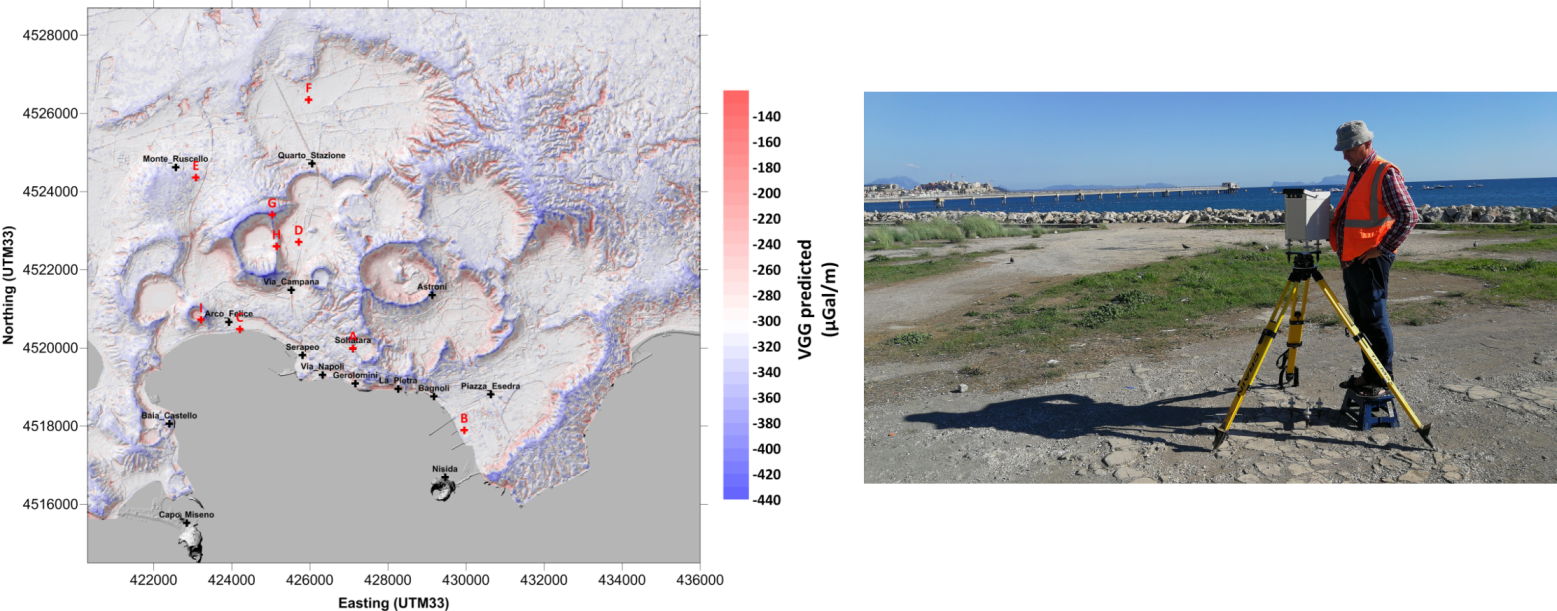
ONDERKA, Milan – PECHO, Jozef – SZOLGAY, Ján – KOHNOVÁ, Silvia – GARAJ, Marcel – MIKULOVÁ, Katarína – VARŠOVÁ, Svetlana – LUKASOVÁ, Veronika – VÝLETA, Roman – RUTKOWSKA, Agnieszka. Applying a time-varying GEV distribution to correct bias in rainfall quantiles derived from regional climate models. In Journal of Hydrology and Hydromechanics, 2024, vol. 72, no. 4, p. 499-512. (2023: 2.3 –
IF, Q3 – JCR, 0.524 – SJR, Q2 – SJR). ISSN 1338-4333.
https://doi.org/10.2478/johh-2024-0025
Climate warming is causing an increase in extreme hydrometeorological events in most parts of the world which is expected to continue and will affect the frequency and intensity of extreme precipitation events. We presented a novel bias correction technique that allows for correcting biases in the upper tails of the Generalized Extreme Value (GEV) distribution while preserving the trend in projected precipitation extremes. The concept of non-stationary bias correction is demonstrated in a case study in which we used four EURO-CORDEX regional climate models (RCMs) to estimate future rainfall quantiles. Historical observations have been used to correct biases in historical runs of the RCMs. The mean relative change in rainfall quantiles between the 1991–2021 historical period and the time horizon of 2080 was predicted to be 13.5% (sd 2.9%) for the return period of 2 years. Upon the return periods of 50 and 100 years, the mean relative change was predicted to be 5.5% (sd 1.1%) and 4.8% (sd 1%), respectively.

VAJDA, Peter – BÓDI, Jozef – CAMACHO, Antonio G. – FERNÁNDEZ, José – PAŠTEKA, Roman – ZAHOREC, Pavol – PAPČO, Juraj. Gravimetric inversion based on model exploration with growing source bodies (Growth) in diverse earth science disciplines. In AIMS Mathematics, 2024, vol. 9, no. 5, p. 11735-11761. (2023: 1.8 – IF, Q1 – JCR, 0.456 – SJR, Q2 – SJR). ISSN 2473-6988.
https://doi.org/10.3934/math.2024575
CAMACHO, Antonio G. – VAJDA, Peter – FERNÁNDEZ, José. GROWTH-23: An integrated code for inversion of complete Bouguer gravity anomaly or temporal gravity changes. In Computers and Geosciences, 2024, vol. 182, jan, art.no. 105495. (2023: 4.2 – IF, Q1 – JCR, 1.129 – SJR, Q1 – SJR). ISSN 0098-3004.
https://doi.org/10.1016/j.cageo.2023.105495
Software tools GROWTH-dg for inversion of spatiotemporal gravity changes and GROWTH-3 for inversion of complete Bouguer anomalies were integrated into one package GROWTH-23 for the inversion of gravity data with enhanced functionality, which was made available for free as open access and open source. Based on several case studies we demonstrated the applicability of this tool for solving the gravimetric inverse problem in several diverse disciplines such as volcano gravimetry, microgravimetry for archaelogical prospection, microgravimetry for sinkhole hazard detection in karstic, mining, and urban areas. Benefits and limitations of Growth were illustrated on case studies of crypts detection in the St. Nicolas Basilica (Trnava, Slovakia), sinkhole hazard in coal mining area in Wolfsberg (Austria), and the analysis of volcanic unrest of 2004–2005 on the island of Tenerife (Canary Islands, Spain).
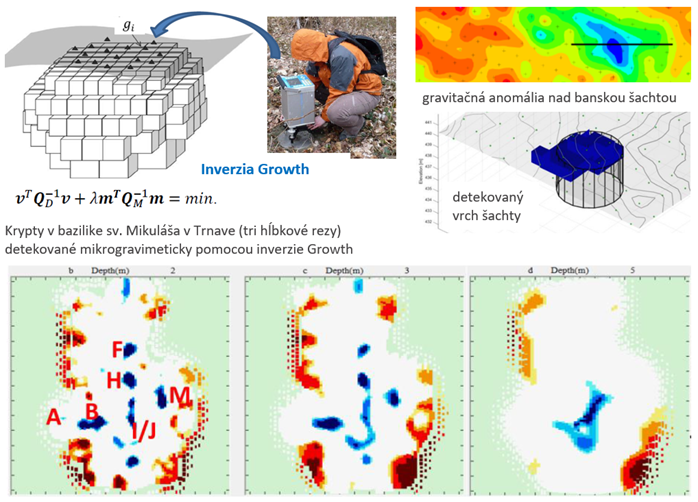
RESEARCH RELATED TO INTERNATIONAL COLLABORATION
JANÁK, Marian – BORGHINI, Alessia – KLONOWSKA, Iwona – YOSHIDA, Kenta – DUJNIČ, Viera – KURYLO, Sergiy – FROITZHEIM, Nikolaus – PETRÍK, Igor – MAJKA, Jaroslaw. Metamorphism and Partial Melting at UHP Conditions Revealed by Microdiamonds and Melt Inclusions in Metapelitic Gneiss from Heia, Arctic Caledonides, Norway. In Journal of Petrology, 2024, vol. 65, no 11, egae114. (2023: 3.5 – IF, Q1 – JCR, 1.976 – SJR, Q1 – SJR). ISSN 0022-3530.
https://doi.org/10.1093/petrology/egae114
The coexistence of melt and multiphase fluid inclusions with diamond suggests fluid-melt immiscibility at UHP conditions. As a result of our study of metapelitic gneisses at Heia, in the Arctic Caledonides of Norway we found diamond-bearing fluid inclusions and melt inclusions of granite composition (nanogranites) in garnet, which is one of the first natural examples. These inclusions reflect metamorphism an partial melting at ultrahigh-pressure P-T conditions of at least 3.7-3.8 GPa and 840-870°, when diamond crystallized from a C-O-H fluid and partial melting was controlled by presence of this fluid.

TOMAŠOVÝCH, Adam – KOWALEWSKI, Michał – NAWROT, Rafał – SCARPONI, Daniele – ZUSCHIN, Martin. Abundance-diversity relationship as a unique signature of temporal scaling in the fossil record. In
Ecology Letters, 2024, vol. 27, no. 7, art. no. e14470. (2023: 7.6 – IF, Q1 – JCR, 4.497 – SJR, Q1 – SJR). ISSN 1461-023X.
https://doi.org/10.1111/ele.14470
Biodiversity in the fossil record increases with time averaging of fossil assemblage samples (e.g. due to decreasing sedimentation accumulation rates). This effect has a key impact on paleoecological analyses as time averaging of fossil assemblages varies by several orders of magnitude, from years and decades to several thousand years. This effect does not only increase the total abundance of fossil shells but also suppresses their species dominance. Based on the analysis of more than 400 Holocene accumulations with subfossil molluscs in the Adriatic Sea, we confirmed that this abundance-diversity (ADR) relationship is indeed positive. In contrast, the ADR relationship is negative in non-time-averaged contemporary mollusc communities collected censused alive (Fig. 1A). The positive ADR observed in fossil accumulations disappears when this relationship is conditioned by sedimentation rates. This finding demonstrates that the high biodiversity of fossil accumulations formed by slow sedimentation is inflated relative to the diversity of the original ecosystems. The effects of time averaging on diversity are particularly significant in deeper environments and therefore cannot be neglected in paleoecological analyses of diversity.

PETRÍK, Igor – JANÁK, Marian – FINGER, Friedrich – KURYLO, Sergiy – KONEČNÝ, Patrik – VACULOVIČ, T. Ordovician (Cenerian) metamorphism in the Western Carpathians: Evidence from EMP monazite dating of polymetamorphosed granitoids in the Veporic unit, Slovakia. In Lithos, 2024, vol. 476-477, art.
no. 107600. (2023: 2.9 – IF, Q1 – JCR, 1.491 – SJR, Q1 – SJR). ISSN 0024-4937.
https://doi.org/10.1016/j.lithos.2024.107600
To the North of Heľpa (Veporic part of the Nízke Tatry Mts.) a new and peculiar granite type was found and identified (Petrík et al. 2024). Detailed petrological study has revealed that, besides primary magmatic minerals, the metagranite contains at least three generations of metamorphic minerals (garnets, kyanite, rutile, monazite). Metagranite recorded several metamorphic events, which implies its high age. Indeed, the dating of one of metamorphic minerals – monazite (CePO4 containing Th and U) has shown that substantial part crystallized during the Ordovician (Cenerian metamorphism 485 Ma ago) but mineral recorded also a younger (Variscan) event (360-380 Ma ago). The oldest monazite cores yielded 520-580 Ma (Fig. 1). Associated granite rocks recorded also the youngest recorded (Alpine) event, ca. 100 Ma ago. The monazite dating confirmed existing zircon data that metagranite from Heľpa belongs to the oldest rocks found in the Western Carpathians (Slovakia). Calculations of pressure – temperature conditions (Fig. 2) of Ordovician metamorphism showed the temperature of 600 °C and pressure of 6 kbars. A possible interpretation is that the area represents Ordovician subduction-accretion complex, a potential source of the subsequent Variscan granitic magmatism.
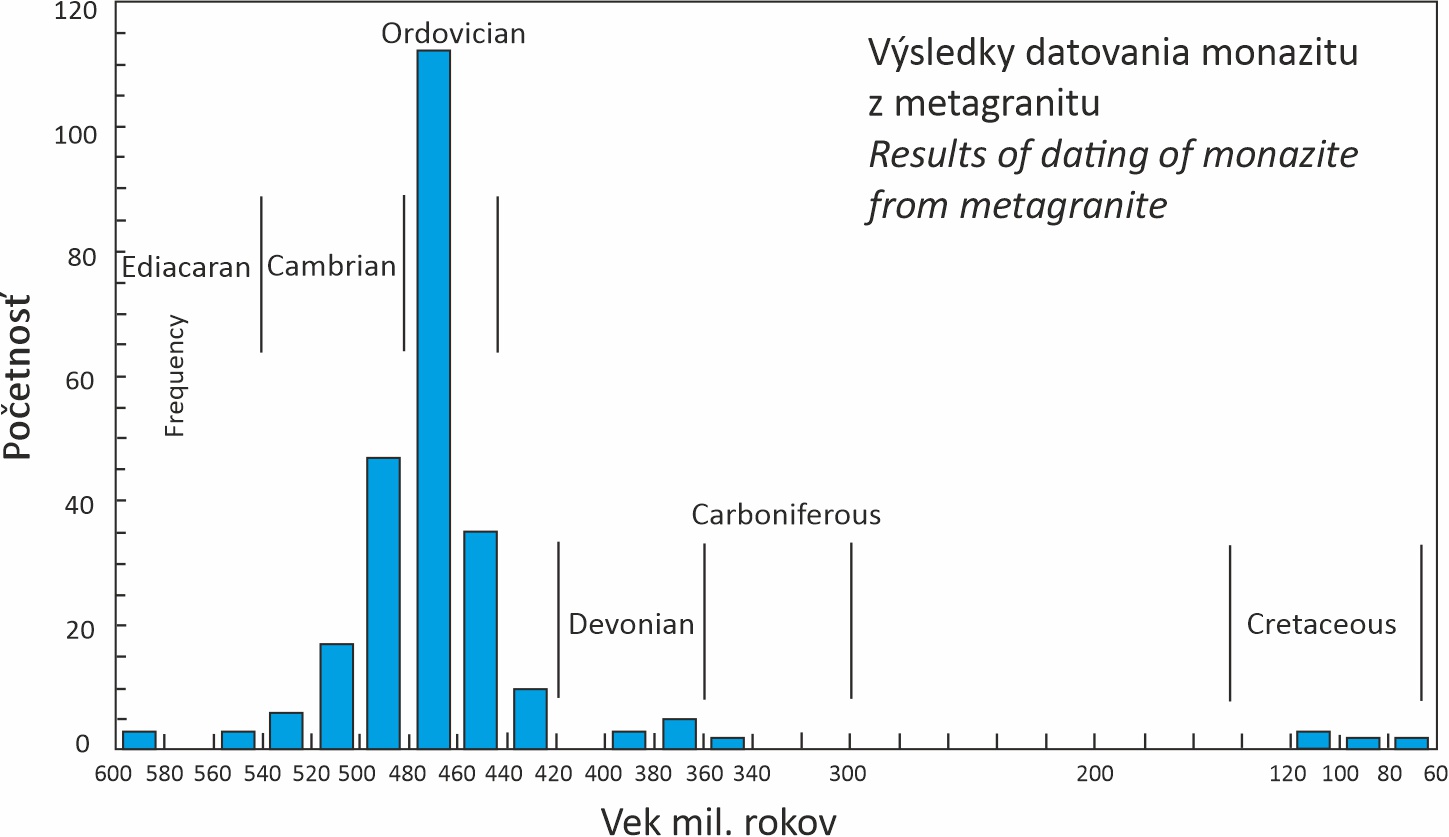
Heľpa metagranite.
